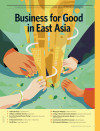 (Illustration by Kimberly Salt)
(Illustration by Kimberly Salt)
The Analects [of Confucius] and the abacus are inseparable. —Shibusawa Eiichi, “father of Japanese capitalism,” 1840-1931
Business for Good in East Asia

This collection of articles, sponsored by the Leping Social Entrepreneur Foundation, delves into the cross-sector collaborations driving the latest social and environmental innovations throughout East Asia, including China, Japan, Korea, and Singapore.
-
Leading the Charge
-
Shifting to a Stakeholder Economy
-
Korea’s New Integrated Business Strategy
-
Seeking Common Ground
-
The SEE Way
-
Managing for Ambiguity
-
Creating a Vibrant Social Innovation Ecosystem
-
Southeast Asian Social Innovation Network
-
Social Investment Funds With a Conscience
-
Next-Generation Philanthropy
How many companies in the world are more than 200 years old? The Bank of Korea identified 5,586 in 2008, and more than half of them are located in Japan. What is the secret of a long-lasting business? According to that research, the answer is: Focus on earning the trust of customers, employees, and communities. This is the core value of sampo-yoshi philosophy, which was practiced by traditional Omi merchants who were successful and active in every part of the country during the Edo and Meiji periods. Translated as “three-dimension satisfaction,” sampo-yoshi suggests that businesses should seek to ensure satisfaction for the three primary stakeholders: the buyer, the seller, and the community.
Fast-forward to 2016, when the Social Innovation Laboratory Kyoto in the city of Kyoto (home of some of the oldest companies on the planet) launched a new certificate program called the “Kyoto Sustainable Enterprise for the next thousand years.” The certification has four indexes by the name shiho-yoshi (four-dimension satisfaction): the company, the customer, society, and the future of mankind.
Moving from three dimensions to four is more than a modern interpretation of what it means to be a good company. East Asia is one of the most dynamic and fastest-growing regions in the world. Export-led economic development in Japan and Korea in the postwar era and in China after the 1978 reforms unleashed a wave of prosperity that swept across the region and lifted millions of citizens out of poverty, resulting in a solid middle class that has emerged in most countries. The meteoric development comes, however, with a price: Economic growth has become the one and only goal. As Jinglian Wu points out in the opening article of this supplement, only 15 years ago economists and business leaders in China believed that as long as entrepreneurs ran their businesses well and made profits, they inherently fulfilled their social responsibilities.
East Asian countries are among some of the richest in the world today. According to a UBS Wealth Management and PwC private banking report in 2018, “New Visionaries and the Chinese Century,” more than half of the new billionaires worldwide are from Asia, with China leading the way and minting more than two new billionaires every week. Significantly, nearly all new entrants are self-made instead of being inheritors of previous generations’ wealth. At the same time, it has also become clear to these nations that wealth and profit don’t promise sustainability or happiness. Asian societies have started to seek solutions by studying theories and best practices from the West, as well as by looking for answers from their own traditions and philosophy that have served those societies for hundreds of years. The challenges of the modern world are of unparalleled complexity compared with those of the last century, however. They include external issues, such as terrorism, and internal ones, such as aging demographics, lack of access to education, and widening income inequality. Governments don’t have the resources to address these issues on their own, and nonprofit organizations don’t have the capacity to scale solutions to meet all needs. Complex social problems demand disruptive and innovative efforts to define root causes and address them in a systematic way. The key question is, how can those societies and those actors pursue cross-sector collaborations that foster social innovation in East Asia?
Which Sector Leads?
In 2017, Leping Foundation collaborated with Stanford Social Innovation Review (SSIR) for the first time to produce a supplement that examined how social innovation is evolving in China, Japan, and Korea. We recognized at that time that despite the growing amount of resources and talent devoted to social innovation, and the increased attention that the concept is receiving in East Asia, few studies have explored how this region as a whole is adopting and diffusing social innovation to solve problems. The supplement received widespread attention and triggered considerable interest, which encouraged us to continue this collaborative learning effort by diving deeper into the topic.
Among the new trends we have seen in this growing field, one that stands out is a movement of “business for good” led by multiple players across the region, from large companies to family businesses to B Corps and social enterprises, and indexes/tools such as United Nations’ Sustainable Development Goals (SDGs), environmental, social and governance (ESG) criteria, and social impact bonds.
Businesses in East Asia are traditionally seen as “fast followers” of those in the West. However, as a result of information technology and other new technologies, innovation is happening not only in developed economies, such as those of Japan, Korea, and Singapore, but also in hybrid economies like China’s. From conventional areas such as automobiles and high-speed railways to emerging fields such as renewable energy, big data, AI robotics, and e-commerce, East Asian countries have emerged as technology powerhouses in the global market. Digital giants like Alibaba and Tencent have created social platforms for more than one billion users to interact in new and novel ways, from connecting with friends and family to picking up a shared bike, from paying bills to launching a business online. But the size of these countries means that new ideas create new problems as well. Consider, for instance, the oversupply of bike-sharing programs in China. Rapid growth has vastly outpaced demand and overwhelmed Chinese cities. Thousands of bicycles have been abandoned, forcing governments to remove them from the streets and store them at “bicycle graveyards.” This is just one example of the unforeseen negative impact of pioneering practices generated by the global sharing economy.
Businesses in East Asia have another reason to play a critical role in promoting social innovation: an underdeveloped third sector compared with those in the US and European countries. Although nonprofit organizations developed rapidly in the last 20 years in Japan, Korea, and China, the structure of a strong state that has a strong grip on power, and a weak civil society that emphasizes economic rather than political rights, remains unchanged. In this environment, it is hard for the third sector alone to scale solutions.
New Insights
This supplement features case studies and research that demonstrate the potential of business to foster social innovation in Northeast Asia and Southeast Asia. Articles examine the largest environmental organization in China, which is run by 900 business leaders; the social enterprise that developed what is now the most popular gay social network app in the world; and the businesses across East Asia that drive societal change in the region by implementing global indexes such as the SDGs Goals and the Benefit Impact Assessment tool.
In each of these articles, the ideas that separate “for-profit” and “for-public” organizations are blurred. The creativity and determination featured in the case studies illustrate the potential that businesses have when they play a leading role in promoting social innovation and solving major problems in the region. At the same time, a fundamental shift from maximizing profits for shareholders to a stakeholder economy that prioritizes sustainability and inclusiveness requires more than cherry-picking a few goals on the SDG chart. Instead, businesses need to prioritize sustainability and inclusiveness by redesigning their strategy to create long-term shared value.
Articles in this supplement demonstrate that social innovation led by businesses in Asia is an emerging field that takes many different forms, and one of the keys to success is cross-sector collaboration that allows businesses to identify the right role to play to maximize their impact. Whether it’s the “collective philanthropy” of 900 business leaders in China, the first health-care social impact bond issued via a partnership between a new foundation and the city of Kobe in Japan, or an LGBT group in China that took a long and winding road to grow into a multimillion-dollar social enterprise, breakthroughs require a deep understanding of local culture. Raising awareness is not always enough, but a first step might be bringing about changes in people’s subconscious behavior.
The good news is that younger generations in East Asia, powered by new technologies, approach societal problems differently than older generations. Whether they are next-generation philanthropists devoted to establishing an ecosystem to support social innovation, or thousands of students who are taking classes on social innovation and sustainability at universities across Asia, this generation sees social issues as part of their mission from day one. They don’t care about format or identity; they are happy to blur the boundaries between business and philanthropy to pursue both profit and purpose. For them, business is a tool to do philanthropy better. Above all, they agree that a healthy society needs to be more diverse and inclusive.
This supplement seeks to provide insight and inspiration on how businesses and leaders in East Asia are responding to new social challenges. At a time of increasing social division within and between countries, we believe that these articles offer hope that entrepreneurs in Asia, like their counterparts in the West, are taking on those new challenges.
Support SSIR’s coverage of cross-sector solutions to global challenges.
Help us further the reach of innovative ideas. Donate today.
Read more stories by Jaff Shen & Fan Li.

